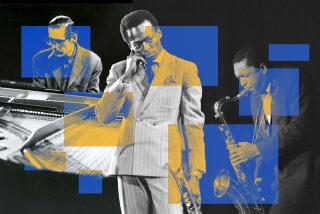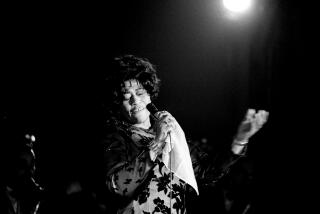A Visit to Ellington’s Movie Mecca
Jazz and movies have had a uniquely linked history, with both arts spanning roughly similar periods of time from the late 19th century to the present. And the music has been present in films from the moment that sound became part of the mix, in the very first sound movie, “The Jazz Singer,” the Al Jolson feature that, ironically, had very little to do with jazz.
On Saturday night at the Ford Amphitheatre, “Jazz Pilgrimage ’98 Goes to the Movies II,” the second annual celebration of jazz and film, elected to explore the far-reaching connection from two specific points of view.
The program’s first half focused on the movie songs that have become part of the jazz improviser’s lexicon of material. Trumpeter Jack Sheldon and pianist Ross Tompkins were featured, roving in highly spontaneous style through a selection of tunes that included “The Days of Wine and Roses,” “Cheek to Cheek,” “You Made Me Love You,” “Emily” and “I Won’t Dance.” Sheldon sang and played on every tune, his interaction with Tompkins a marvelously intimate display of the subtle manner in which jazz artists can respond to each other’s musical moves.
Did their performance specifically relate to jazz in films? Not really. But in the duo’s playing and, more pointedly, in Sheldon’s off-the-wall humor, it offered a fast take on the kind of quick-witted jazzman’s style that movie-makers have tried--with consistent lack of success--to capture on film. His hilarious description of “Casablanca”--complete with characterizations of the leading players--as a lead-in to “As Time Goes By” was priceless.
The program’s second half was an ambitious re-creation--featuring drummer Louis Bellson’s 16-piece big band--of Duke Ellington’s film music for “Paris Blues,” “Anatomy of a Murder” and “Assault on a Queen.” Although occasionally in need of more rehearsal, the music was generally well-played. Lead alto saxophonist Rick Lozano, in particular, captured the essence of the Ellington sound in his convincing simulation of the legendary Johnny Hodges.
The problem with the presentation was that film music, whether by Ellington or anyone else, is intended to service the picture and the story. And a good half of the pieces, despite their Ellingtonesque qualities, essentially sounded like background music.
So call it a noble effort, worth doing less for the music’s performance value than for the historical enhancement it adds to the existing catalog of Ellingtonia.
More to Read
The biggest entertainment stories
Get our big stories about Hollywood, film, television, music, arts, culture and more right in your inbox as soon as they publish.
You may occasionally receive promotional content from the Los Angeles Times.










